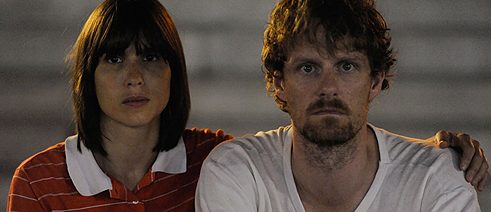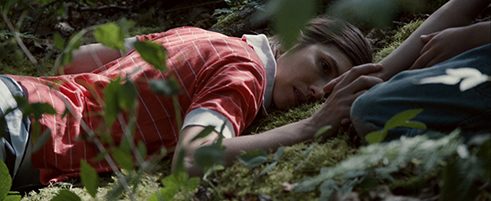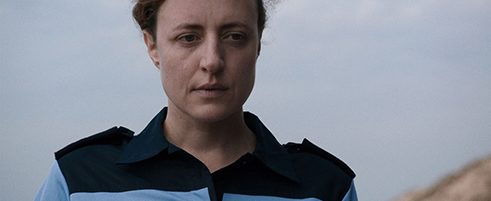Film review
The Dreamed Path: Life’s mundanities flicker like memories

Kenneth (Thorbjörn Björnsson) moves a chair, tentative and uncertain. His mother is in the room, moments away from dying. His father sits on the bed, his eyesight failing along with his composure. “I don’t know where to put myself,” Kenneth remarks, and while his voice doesn’t echo, the sentiment lingers. Where someone stands or reclines when the woman who brought them into the world makes her final goodbye is something equally inconsequential and of paramount importance — it won’t matter at all later, but it desperately does in the moment.
The Dreamed Path starts Kenneth’s journey earlier, when he’s holidaying in Greece with his girlfriend Theres (Miriam Jakob), busking on the streets for change and watching the locals rally about the country’s acceptance into the European union. His vacation ends with a call about his mother’s sudden ill fortune, and, even though they both return to Germany, so does much of his time with Theres. Once the film offers snippets of their experiences, it segues from their 1980s antics to the present day, and to Berlin-based married couple Ariane (Maren Eggert) and David (Phil Hayes). An actress and an anthropologist with a pre-teen daughter (Anaïa Zapp), they’re caught in their own family, relationship and existential dramas.
Exhibiting emotional coherence
 In 'The Dreamed Path' writer/director Angela Schanelec empathises the idea that the mundane and the significant can be one and the same
| © The Dreamed Path
It’s telling that The Dreamed Path’s German title, Der traumhafte Weg, actually translates as “the dreamlike path”; though writer/director Angela Schanelec explores events grounded in reality, her film morphs from one image to the next as though projected onto the screen from her flickering mind. And yet, while there mightn’t always be narrative specificity or logic to the ordering of scenes, or even the minutiae that is seen, there’s emotional coherence. As Kenneth’s seating placement so deftly and devastatingly illustrates, everything in life is simultaneously trivial and momentous when it’s occurring. It’s often only in hindsight that true relevance and consequence becomes apparent — when filtering through memories, recollecting and reflecting, at a later date.
In 'The Dreamed Path' writer/director Angela Schanelec empathises the idea that the mundane and the significant can be one and the same
| © The Dreamed Path
It’s telling that The Dreamed Path’s German title, Der traumhafte Weg, actually translates as “the dreamlike path”; though writer/director Angela Schanelec explores events grounded in reality, her film morphs from one image to the next as though projected onto the screen from her flickering mind. And yet, while there mightn’t always be narrative specificity or logic to the ordering of scenes, or even the minutiae that is seen, there’s emotional coherence. As Kenneth’s seating placement so deftly and devastatingly illustrates, everything in life is simultaneously trivial and momentous when it’s occurring. It’s often only in hindsight that true relevance and consequence becomes apparent — when filtering through memories, recollecting and reflecting, at a later date.Indeed, Schanelec not only embraces the idea that the mundane and the significant can be one and the same in her seventh feature (with previous efforts Places in Cities, Passing Summer and Afternoon all conjuring similarly wistful images, if only from their titles) — she emphasises it over her story. And, she does so through her poetic and precise visuals, with her use of the boxed-in Academy ratio showing everything as well as nothing. At times, she hones in on items and objects, such as coins falling into a cap, continuing the film’s fascination with perfunctory intricacies. At others, she shows action by depicting as well as withholding, such as only glimpsing Kenneth’s midsection when he almost faints upon first hearing about his mother’s condition.
 In the film 'The Dreamed Path' (German title: ‘Der traumhafte Weg’) Angela Schanelec explores events grounded in reality
| © The Dreamed Path
It’s an approach as lyrical as it is detail-oriented, and as oneiric and it is steeped in relatable instances. Here, fractures reign — in two tales, two couples, life and death, comings and goings, visual juxtapositions and shifting importance and contrasting imagery — but so does a sense of unity. In fact, though it is usually used as a criticism, the concept of not seeing the forest for the trees proves an apt description of The Dreamed Path, and not only for its inclusion of natural splendor to break up concrete urbanity and non-descript interiors. A film filled with street-side renditions of “The Lion Sleeps Tonight”, both life and romance coming to an end, routine occurrences such as leafing through books and lazing about in bed, multiple hospital visits, watery vistas, and bags packed, unpacked, swapped and ferried about, it eschews the thicket for the foliage to willingly revel in the detail of each part of the broader whole, and also interprets them as its own magical garden.
In the film 'The Dreamed Path' (German title: ‘Der traumhafte Weg’) Angela Schanelec explores events grounded in reality
| © The Dreamed Path
It’s an approach as lyrical as it is detail-oriented, and as oneiric and it is steeped in relatable instances. Here, fractures reign — in two tales, two couples, life and death, comings and goings, visual juxtapositions and shifting importance and contrasting imagery — but so does a sense of unity. In fact, though it is usually used as a criticism, the concept of not seeing the forest for the trees proves an apt description of The Dreamed Path, and not only for its inclusion of natural splendor to break up concrete urbanity and non-descript interiors. A film filled with street-side renditions of “The Lion Sleeps Tonight”, both life and romance coming to an end, routine occurrences such as leafing through books and lazing about in bed, multiple hospital visits, watery vistas, and bags packed, unpacked, swapped and ferried about, it eschews the thicket for the foliage to willingly revel in the detail of each part of the broader whole, and also interprets them as its own magical garden.